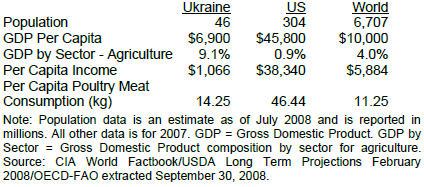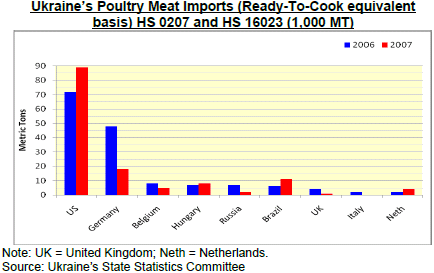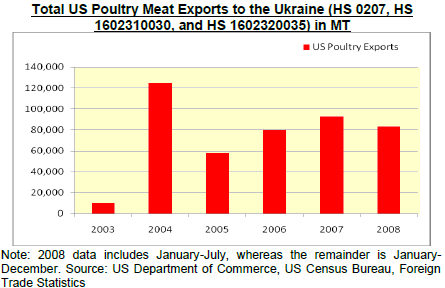



International Egg and Poultry Review
US - By the USDA's Agricultural Marketing Service. This is a weekly report looking at international developments concerning the poultry industry. This week's report covers the poultry situation and outlook in Ukraine.Ukraine
Domestic Production
Ukraine’s domestic poultry production in 2008 to 2009 grew 20% to 25%, which remains unchanged from last year’s growth levels and is what is projected for next year as well. The growth is attributed to increases in incomes among low-income and middle-income consumers, existing domestic producers operations being fully operational, and by the restriction of imports in the end of 2007 and early 2008. Ukraine’s poultry industry continues to be dominated by two large vertically integrated companies representing 70% of the country’s production; however backyard poultry farming continues to be practiced as an alternative to the rural population though it is gradually diminishing.
Consumption
Poultry meat consumption continues to increase, due to rising incomes and a growing price differential between red meat and poultry items. Consumption in 2008 will continue to increase with growth expected in both retail (predominantly domestically produced chilled poultry) and further processing sectors (both imported frozen poultry and domestically produced poultry). Retail poultry prices remained relatively steady ($4-$6 per kilogram (kg)) despite red meat trade restrictions and increasing pork prices. After restrictions were lifted by the state in June 2008, imported products were well received by the less affluent and more rural populations at supermarkets. Additionally, it was interesting to note Ukraine’s avian influenza (AI) outbreak back in January 2008 had no real significant influence on poultry consumption.

Export/Import Trade Situation
Despite the volatile trade environment in late 2007 and 2008, the revised 2007 trade estimates by FAS Kyiv were close to actual numbers. Though the trade forecast for the rest of 2008 and 2009 is subject to trade policy changes, it is certain shipments to Ukraine will be considerably higher than the previous year’s levels and the poultry market will continue to be influenced and operated by supply and demand factors and not be limited by prohibitive tariffs.
The trade increases felt in June and July 2008 were a direct result of the GOU responding to intense criticism for high meat prices and high inflation after it eliminated import loopholes and Free Economic Zones (FEZs), imposed high import taxes, decreased imports triggering a supply shortage to the meat processing industry, and caused food prices to soar. It reacted by reopening the commercial poultry market and initiated the State Reserve as an appointed GOU buyer. As of August 1, 2008 the State Reserve had procured more than 60,000 tons of poultry for delivery through the end of the year.
However the recent trade increases are not expected to continue due to a variety of reasons. First, Ukrainian ports will no longer be able to transship 25-30,000 tons of poultry per month due to a lack of cold storage facilities, nor will the Ukrainian market be able to accept such significant additional poultry volumes as declared by the GOU. Consumers in Ukraine have become accustomed to chilled domestic poultry and view frozen imported poultry to be a step backwards and see the cheaper prices on frozen imported poultry to be reflective of the products quality. In addition, the State Reserve is not a business entity and will not be able to secure trading with Ukrainian retailers to sell all product contracted. Lastly, domestic producers lowered prices to consumers by 10% to 15% to retain consumer loyalty.
On a side note, Ukraine’s domestic poultry producers have not only invested heavily in their operations, but they have also explored the export marketplace with its first exports to Kazakhstan in 2008. Despite a lack of profit yield and impact on domestic prices, it represents Ukraine’s attempt and desire to establish market connections and a possible competitor to the US in the Former Soviet Union (FSU), Asian, and Russian markets. Furthermore Ukraine concluded WTO Accession talks in early 2008 after 14 years of negotiations. Ukraine ratified its Accession Protocol; however it rejected the WTO compliant Customs Tariff and failed to approve any compliant drafts. It did implement new WTO-agreed import custom duties with Order # 14/655-EP May 16, 2008, however the old Customs Tariff remains valid and an unresolved legal conflict.
Note: GOU = Government of Ukraine. The State Reserve is a state institution responsible for storing a selected set of goods to satisfy the country’s needs over special periods (i.e. war, emergency situations) as well as for stabilizing markets through commodity interventions during supply and demand imbalances or critical shortages. Source: USDA FAS/US Department of Commerce, US Census Bureau, Foreign Trade Statistics


Further Reading
| - | You can view the full report by clicking here. |








